I
Fabian Butkovich:
@Rick Veregin so it turns out I did have super pixel mode selected, however, I was under the impression that when stacking narrowband data (which I am) this setting should be chosen for best results? At least thats what DSS recommended for narrowband data.

Was I shooting myself in the foot this entire time when stacking my images by having this checked? What are the best settings to use for narrowband images then?
Also, I do have drizzle checked as I saw in a video from Astrobackyard he recommends always enabling 2X drizzle when stacking and then downsampling later, since I am defining a custom boundary box this is why I was able to get my result framed correctly.
I'm trying to remember why SuperPixel mode can give problems like this. But if you are using superpixel mode that combines pixels, reducing the number by 4X, but then adding drizzle doubles the pixels each dimension increasing by 4X the pixels, this could be it. I bet the two are totally confusing each other. But possibly there are other issues, as I said, SuperPixel mode can cause issues like getting 1/4 of the frame, I just can't recall what the interactions are.
You are using an OSC camera with a dual band filter is that it? If you are truly narrow band then you would be mono, and not debayering? I think this is what superpixel was meant for, a true narrow band mono image. And I think there are some issue around perhaps debayering with anything other than bilinear, when using superpixel and an OSC camera, but I don't recall for sure.
For an OSC camera with a duoband filter I use bilinear debayer, as I do with broad band RGB--this seems to work best. For true narrowband mono I do not use superpixel, I use exactly the same settings as for other images. If I want to do a 2X bin a NB Ha for example (same as Superpixel) I do it in Startools (or you can do it in PI or PS, whichever you use for post stack processing). No need to do it in DSS, easy enough to do it later and see if it helps or hurts. And this avoids problems with Superpixel mode.
I do not find doing any of the calibrations in DSS useful, I think a lot of this is legacy stuff, that maybe had a basis when the program was initially written. The program is in new hands now, where the focus has been improving the code, but not changing the basics behind it. My suggestion is to be careful of doing more than basic register and stack in DSS. I find the 2X drizzle does work well, as by the way does the rejection methods rather than basic averaging. And those things must be done in stacking, so one can't put them off to do later.
But otherwise, I do any other calibration/binning later that I can do later. Indeed, Startools, which I use for processing my DSS stacks, warns not to have DSS to do anything to the image in terms of WB, background calibration, etc. I suspect if you use PI that would be best too, PI will do anything much better than DSS. DSS is not wonderful for image processing, so limit what you do there in terms of color balance and background calibration. Any other processing software can do a better job.
Rick





